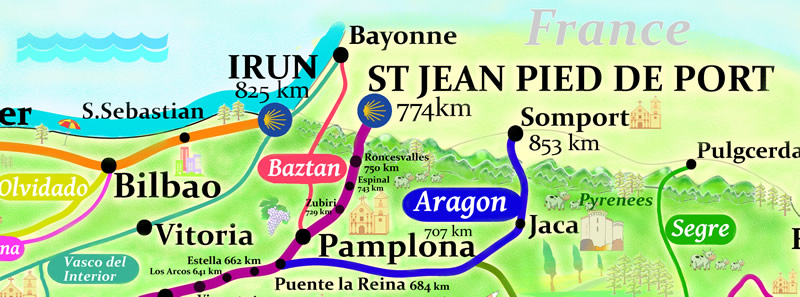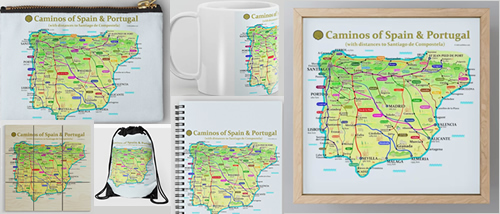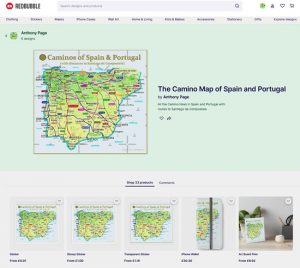Our Camino de Santiago Routes Map

Caminos de Santiago Rutas España & Portugal
This is our Camino de Santiago routes map for Spain and Portugal.
There are over 50 Camino routes on the map, which is updated when there are new paths.

The map was digitally created over many weeks with exceptional attention to detail.
We sell through our online partner Redbubble who will create and ship your product worldwide and in your own currency.
Camino de Santiago Routes Map
The map features of 50 Camino de Santiago routes through Spain and Portugal. Some of the routes don’t actually finish in Santiago, but will joins other Camino roads that will end in the cathedral of Santiago.

The French Way – Camino Frances
The French Way is the most popular Camino de Santiago which can both be considered as starting in Saint Jean Pied de Port (a small town in the French Basque Country) and in Roncesvalles (a small town in the Navarrese Pyrenees). The most popular Way of all the Caminos de Santiago, with a big difference in the number of pilgrims (more than 85% of the total) compared to the other Ways. It owes its origin to three of the four main historical pilgrimage routes that come from the interior of Europe, which converge in the small town of Ostabat, a few kilometers from Saint Jean Pied de Port.
The Portuguese Way – Camino Portuguese
It is known as the Portuguese Way , or more specifically the Central Portuguese Way (for a better distinction from the others), the Jacobean way that connects Lisbon with Santiago de Compostela. Its route draws a line from south to north, which from the Portuguese capital would pass through Santarém, Coimbra, Porto, Barcelos, Ponte de Lima, Valença do Minho, Tui, Pontevedra and Padrón. Used since the Middle Ages, it has always been one of the most important routes to Santiago and today it is the second route in number of pilgrims , only surpassed by the French Way.
Although this is the best known and most used, there are many other roads to Santiago in Portugal. For years old routes have been recovering, although most would be tributaries or variants of the Central Way: the most frequented is the Portuguese Coast Way , which starts in Porto and follows an itinerary close to the sea; from the same city an alternative – for now a minority – can also be taken, such as the Braga variant ; Another branch would start in the south, from Faro and the Algarve region , although it still has sections that are still not marked, and which we hope will soon allow us to travel the country from one end to the other.
Northern Way – Camino del Norte
The Camino del Norte (or Camino de la Costa ) is the Camino de Santiago that begins in Irún and runs along the Cantabrian coast. Until Ribadeo, the first Galician town, the route follows the coastline (not always near the coast), and it is from the aforementioned town that the route moves away from the coast to go to the Galician capital. The Northern Way is one of the historical paths that medieval pilgrims followed to visit the apostle’s tomb, although historians agree that it was never very frequented due to the intricate orography and the smaller number of towns that offered hospitality.
Today the Camino del Norte, along with the Vía de la Plata and the Camino Portugues, has become a good alternative to the French Way for all those walkers who want to escape from the overcrowding and trivialization that this road has suffered in recent years. . Or they want a more committed or spiritual pilgrimage. Or they are looking for landscapes that in the popular imagination are more spectacular than on other routes, as this is a coastal path.
Every year the number of pilgrims increases strongly on the Cantabrian route. In 2009 there were 9,183 pilgrims, and in 2017 there were 17,836. A large part of them have already traveled the French Way and are looking for new experiences. It is also true that if on the French Way, in the overall year, there is a certain balance between the number of Spanish pilgrims and foreign pilgrims, on the Cantabrian route the balance is clearly broken in favor of the latter (with the month of August as the only exception).
Via de la Plata – The Silver Way from Seville
This road is known by various names: Vía de la Plata (the most used, but which not only refers to the pilgrimage route), Ruta de la Plata (more current and usually refers to its tourist side), and Camino Mozárabe to Santiago (in this case it refers exclusively to the pilgrimage route). The road that from Granja de Moreruela, a town located 40 kilometers north of Zamora, goes to Santiago through Puebla de Sanabria and Orense, is also known as the Camino Sanabrés. And, as if that weren’t enough, the road between Salamanca and Santiago through Puebla de Sanabria and Orense is also known as Camino Fonseca.
The Vía de la Plata owes its origin to a set of Roman roads that linked the southwest with the northwest of the peninsula. In its central section the Roman road presents the current technical name of Iter Ab Emerita Asturicam ; it united two Roman towns of great importance: Emerita Augusta (Mérida), capital of the Roman province of Lusitania, and Asturica Augusta (Astorga). Centuries later, these magnificent stone-paved roads were used by the Arabs in their conquest of the peninsular territories, and later, once the Christian reconquest was completed, it was the devotees of Santiago who followed these roads on their pilgrimage to the tomb of the Apostle. The denomination “Silver” it has nothing to do with silver metal. Its origin is not known for sure, but the most likely hypothesis seems to be that of a phonetic evolution of the Arabic word Balata , which means paved road.
The Primitive Way – Camino Primotivo
The Camino de Santiago is known by the name of the Primitive Way, which has its origin in Oviedo and connects with the French Way in Melide. The name “primitive” is due to the fact that this is the first path of which there are historical references; King Alfonso II of Asturias and his entourage left Oviedo in the 9th century to visit the tomb of the Apostle Santiago, discovered a few years ago. The documented itinerary of that first pilgrimage and the current one are quite coincident.
One of the main characteristics of this path, compared to the other Caminos de Santiago, is the hardness of the route. From Oviedo to Lugo it is a typical medium mountain route. Except for the descent to the Salime reservoir and the ascent to Puerto del Palo, there are no major slopes to overcome in one go. However, the road is a continuous up and down, with a succession of all kinds of roads: trails, trails, dirt tracks (it is easy to find muddy sections), stony or loose stone roads, and asphalt tracks. Therefore, a minimum of physical preparation is necessary to face the challenge with guarantees. Fortunately, the distribution of the shelters along the route allows, for those somewhat slower or less prepared, to go all the way without having to do any excessively long stage. In winter it must be really difficult to do this path.
Way of Fisterra and Muxía
It is known as the Camino de Fisterra y Muxía the extension of the Camino de Santiago that connects the Galician capital with Cape Finisterre and with Muxía, both located on the legendary Costa da Morte . It is a different and unique route, since it is the only one that does not lead to Compostela, but starts from there , and for that reason it is used as a continuation or epilogue of the path followed by each pilgrim, walking the few days that remain until the end of the world. .
It is estimated that between 10 and 15% of the pilgrims who arrive in Compostela continue their journey to Fisterra , and many of them also take the opportunity to get closer to Muxía (the link stage is signposted in both directions , Fisterra-Muxía or Muxía- Fisterra, by means of markers and double arrows). There are even those who, after visiting both final destinations of the Jacobean route, continue walking back to Santiago, making an almost circular route.
The Camino de Santiago through France
The Camino de Santiago was born with an international vocation; In the Middle Ages the vast majority of pilgrims came from beyond the Pyrenees, from the interior of Europe, and their passage through France established four main routes , now recovered as Long Distance routes. France has always felt linked to the pilgrimage to Compostela; It is no coincidence that the first modern pilgrim association, founded in 1950, was the Society of Friends of the Paris Way. We present here the four medieval routes, adding the Camino del Piedmont.
Le Puy path
The Camino de Le Puy (or Via Podiensis ) is the main route through France and the most important medieval European pilgrimage route. The first documented pilgrimage is that of Bishop Godescalc between the years 950 and 951.
Arles road
The Camino de Arles , also known as the Via Tolosana because it crosses Toulouse, the capital of Occitania, is one of the four great Jacobean itineraries in France. Mentioned already in the Calixtino Codex (12th century).
The Camino de Santiago offers a range of routes that attract pilgrims from around the world. There are more than 30 designated Camino routes, with the most popular being the Camino Francés, Camino Portugués, and Camino del Norte. Each path provides unique landscapes, cultural experiences, and historical sites, allowing travelers to choose a journey that best suits their preferences.
As pilgrims seek personal growth, adventure, or spiritual fulfillment, they may find themselves wondering which route to embark upon. The variety of Camino routes ensures that there is something for everyone, whether one prefers a serene countryside trek or a challenging mountain hike. The diversity of these pathways not only enhances the pilgrimage experience but also reflects the rich history of this centuries-old tradition.
Exploring the different routes reveals fascinating stories and connections to Spain’s cultural heritage. Knowing the options available can help travelers plan a memorable pilgrimage that resonates with their individual journeys.
Overview of the Camino Routes Map
The Camino routes have a rich history and a diverse geographical presence. Understanding their development and spread aids in appreciating the significance of each route.
Historical Development
The Camino de Santiago, associated with the pilgrimage to the shrine of Saint James, has roots dating back to the 9th century. The discovery of Saint James’ remains in Galicia prompted pilgrimages, which evolved into a network of routes.
Initially, the primary route, known as the Camino Francés, emerged from France. Over the centuries, additional paths were established, influenced by local customs and geography. By the Middle Ages, the Camino became one of the most significant Christian pilgrimage sites in Europe.
The routes faced decline during the Reformation but experienced revival in the late 20th century. Organizations and local communities have since worked to restore these paths, promoting them as cultural and spiritual journeys.
Geographical Spread of the Camino Routes
The Camino routes extend across several countries, primarily in Spain, France, and Portugal. Each pathway offers unique landscapes and cultural experiences.
Key routes include:
- Camino Francés: Starting from Saint-Jean-Pied-de-Port in France, this is the most popular route.
- Camino Portugués: Beginning in Lisbon or Porto, this route highlights Portugal’s scenic beauty.
- Camino del Norte: This northern route along the coast of Spain offers dramatic seaside views.
- Via de la Plata: This southern route stretches from Seville to Santiago, showcasing historical towns along the way.
In total, there are numerous variations of these main routes, making the Camino accessible to a wide range of pilgrims. Each path reflects the local heritage, religious significance, and the camaraderie of those who undertake the journey.
Redbubble will ship worldwide.

